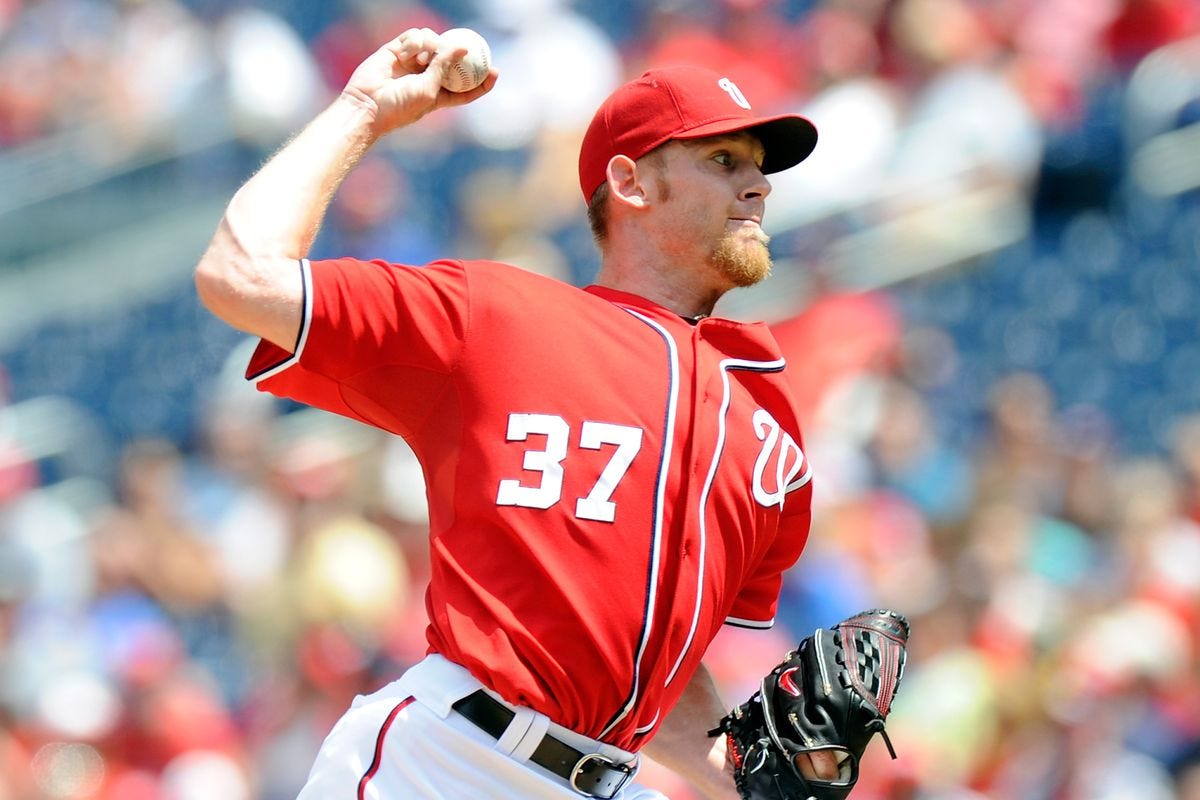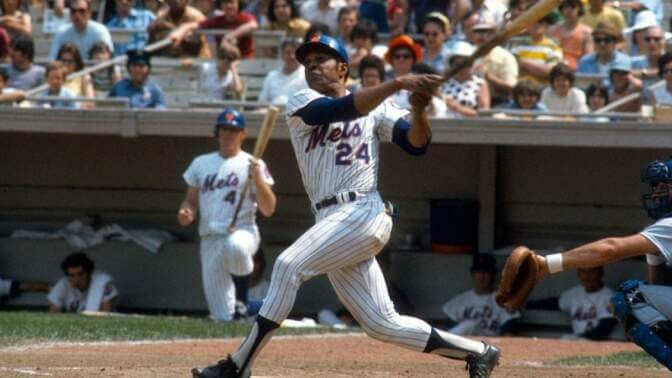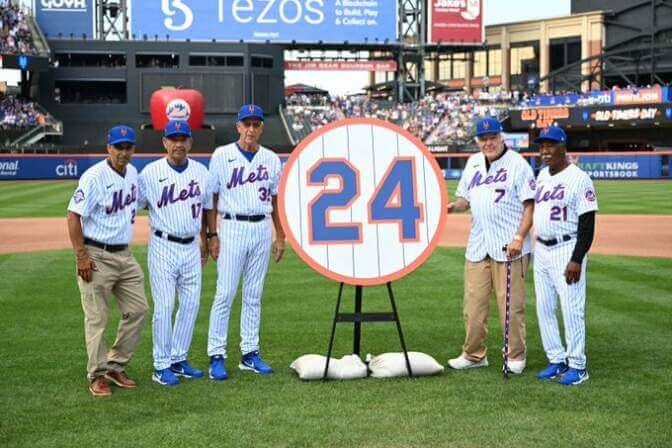Washington Finds New Mark For Futility
ALSO: PRO AND CON ON THE RETIREMENT OF WILLIE MAYS' NO. 24 BY THE METS
IBWAA members love to write about baseball. So much so, we've decided to create our own newsletter about it! Subscribe to Here's the Pitch to expand your love of baseball, discover new voices, and support independent writing. Original content six days a week, straight to your inbox and straight from the hearts of baseball fans.
Reader Reacts
Good idea moving the World Baseball Classic to November! It makes total sense!
— Bill Beck, Arizona
Bill Beck worked for the San Diego Padres and Miami Marlins.
Pregame Pepper
Did you know…
On Aug. 31, Max Fried (2.56), Kyle Wright (2.99) and Spencer Strider (2.87) all held ERAs below 3.00, marking the first time since 1997 that Atlanta has had three consecutive starts by pitchers with sub-3.00 ERAs this late in the season, according to the Elias Sports Bureau. Greg Maddux (2.33), Denny Neagle (2.83) and John Smoltz (2.89) started Sept. 1-3 games against the Tigers that season . . .
Bad news for the Cleveland Guardians: pitcher Zack Plesac is on the IL with a fractured pinkie and could be gone for the duration . . .
With the Tampa Bay Rays quickly gaining ground in the AL East, the Yankees have called up blue-chip shortstop prospect Oswaldo Peraza . . .
The mistake-prone Los Angeles Dodgers looked like Little Leaguers in their latest loss at CitiField, allowing the New York Mets to win the season’s series, 4-3.
Leading Off
43 Straight Games Without a Starter Winning
By Andrew Sharp
Washington’s Tanner Rainey saved a 3-2 victory for Josiah Gray over the Phillies on July 6 in Philadelphia. As poorly as the 2022 Nats were playing, nobody could imagine then that it would be seven weeks – 43 games – before another Nationals’ starting pitcher would win a game.
Victories by starters clearly are far less significant today than historically -- witness 10-game winner Jacob deGrom’s Cy Young award in 2018. But casual fans still take note of a starting pitcher’s won/loss record when weighing a team’s chances. Better to be, say, 13-3 than 4-17, the depth to which the Nats’ Patrick Corbin sank.
The weird streak began on July 7 with the Nationals losing the first of nine straight, all but one of those losses charged to the starters.
And it must have taken an incredible amount of bad luck -- especially for a team with Josh Bell and Juan Soto hitting in the middle of the order through August 1 -- for a starter not to stumble into a win when his team scored a lot of runs early. It didn’t happen to these Nats, however.
During the streak, just two starters left the mound with a lead. On August 2, Cory Abbott left after five, ahead of the Mets, 1-0. Francisco Lindor led off the sixth with a homer off Victor Arano to tie it. Despite the blown save, Arano won when the Nats rallied to win, 5-1.
On August 10, Gray had given up a homer and a single but still led, 2-1, when Steve Cishek relieved him in the seventh. The inherited runner scored two batters later, and the Cubs ended up winning.
The bullpen took the loss in four games during the steak. The starters were losers 27 times. Obviously, the relievers collected all 12 victories during the starters’ run of futility.
Sixteen times during the streak, the starter did not last the five innings needed to qualify for a win. Corbin was 0-7, Anibal Sanchez was 0-5, Paolo Espino 0-4, Gray and Eric Fedde, on the IL for much of time, both were 0-3. All five had no-decisions, as did Cory Abbott, who made several starts. None of the starters went as many as seven innings.
No Max Scherzer or a healthy Stephen Strasburg in that bunch.
The Nationals tied the record for starting pitcher futility at home on August 17, against the Cubs. Abbott went six innings, but the best the Nats could do was a 2-2 tie headed to the seventh. The bullpen took a 3-2 loss, the 35th time in a row without a starter winning.
That kept the record in town: The last-place 1949 Washington Senators, which lost 104 of its 154 games, established the post-1900 standard with 35 straight games with starters not winning.
The Nationals broke that record the next night in San Diego, even as Washington was defeating the Padres, 3-2, with two runs in the ninth. Soto and Bell, Padres now, were on hand to watch.
The streak came close to ending before Washington left San Diego. A pair of 2-1 losses were inflicted by the two stars the Nats had traded. After yielding a game-tying homer to Bell, Gray was done after five innings and a 1-1 tie. Soto’s seventh-inning homer won it. The next day, Corbin carried a 1-0 lead into the sixth. Bell’s two-run homer took care of that. The streak reached 39 games.
At 43 games, it finally ended. On August 28, Corbin went six innings against the Reds and left with a 3-2 lead. Hunter Harvey, Carl Edwards Jr. and Kyle Finnegan made it stand up. Corbin, leading the league in losses, won for just the fifth time. Post-game interviews made clear all the Nationals knew well how long the streak had lasted.
The amazing run of futility came just three seasons after the Nationals’ starters in 2019 went 27 consecutive games without suffering a defeat, tying the MLB record set by the 1916 Giants.
The fall has been speedy and deep for the 2019 World Series winners.
Andrew C. Sharp is a retired journalist and a SABR member who blogs about D.C. baseball at washingtonbaseballhistory.com
Cleaning Up
Did Willie Mays Deserve To Have His Number Retired By The Mets?
By Phil Hecken
[Editor’s Note: As Weekend Editor of Here’s The Pitch, I normally reserve this space for my own column but this one from Uniwatch deserved publication, especially since it mirrored by thoughts on the subject. It is reprinted with permission of the author. — D.S. ]
In case you missed it, on Saturday, the New York Mets finally retired Number 24 for Willie Mays, one of baseball’s greatest players. This was a surprise move by the team, who concurrently held their first “Old Timers” Day since 1994. Some of you may be saying, “What took them so long?” That question could apply both to the return of Old Timers Day and Mays’ number retirement.
Mays was a New York icon, having broken in with the New York Giants in 1951 as a 20-year old rookie (who won the Rookie of the Year Award that season). He played a portion of the 1952 season before entering military service, returning to the Giants full-time in 1954. He would play a total of six seasons in New York for the Giants, before the team moved west to San Francisco, where he played until 1972. At the age of 41, Mays was traded from the Giants back to New York, where he played the remainder of that season, and the entire 1973 season — which culminated in a World Series appearance — with the New York Mets.
Normally, I’d say, “Mays is an all time great, Hall of Famer, and legend, but there’s NO WAY he deserves his number retired by the Mets, for whom he played less than two seasons.” And it wasn’t like Mays put up great numbers or did Amazin’ things with the Mets. In those two seasons, he batted .238, with 14 homers and 44 rib-eye steaks. Sure, he “helped” the team make the 1973 World Series, and brought some thrills and joy to fans in Queens and New York, many of whom still had some very cherished memories of Mays doing incredible baseball things at the Polo Grounds with the Giants. He was, in short, a conquering hero returning home.
But while he may have been a New York National League baseball God, he wasn’t a very good player for the Mets; at least not one deserving of having his number retired. Or so I always thought.
Before Mays got to the Mets, six different players wore the number 24. Mays was the seventh. You’d have thought if the Mets were going to retire his number, they’d 1) have done so a long time ago; and, 2) they’d at least have held it out of circulation. But no, that’s not what happened: while the team didn’t issue #24 to any player for almost 27 years, somehow the team issued it to the legendary Kelvin Torve (who?) in 1990. He had it for all of 10 days. Rickey Henderson (another baseball legend and Hall of Famer) joined the Mets in 1999, and he wore #24. He’d wear it for two seasons (and then again for a short stint with the team in 2007). Finally, disgraced PED-abuser Robinson Cano was given the number in 2019, and he wore it until the team finally DFA’ed him earlier this season.
So, almost 50 years passed and three additional players wore #24 before the Mets finally retired it for Mays on Saturday.
Why didn’t the Mets retire Mays’ number back following his retirement after the 1973 season? Well, they had actually planned to: Mets charter owner Joan Whitney Payson told Mays he would be the last player in franchise history to wear #24. (It may have even been one of the reasons why Mays agreed to the trade back to New York). But Payson died in 1975, not long after Mays’ retirement in 1973. And that’s where the team dropped the proverbial ball. According to SABR, “After Joan Payson died in 1975, her shares were bought by her husband Charles Payson, making him the majority stockholder with nearly 90 shares. Mr. Payson was not really much of a baseball fan, preferring instead to remain involved in his own businesses and occasionally going out bird hunting at their home on the Florida Gulf Coast.” Charles Payson, who owned the team until 1980, never bothered to retire Mays’ #24, per his wife’s agreement with Mays, and neither did the next few owners of the Mets.
Through Nelson Doubleday and later Fred and Jeff Wilpon, the team seemed ambivalent towards honoring the late Mrs. Payson’s wishes. The Mets had only retired four numbers: two for managers (Casey Stengel and Gil Hodges) and two for players (Tom Seaver and Mike Piazza). There was a strict retirement policy in place: only players who entered the Hall of Fame as Mets would have their numbers retired. That’s fine, and I have no problem with those criteria. But that all changed when Steve Cohen purchased the team in 2020.
Cohen decided the criteria for retired numbers was too strict, and last season, the team retired #36 for Jerry Koosman — a great player, but not a Hall of Famer. Earlier this year, the team retired Keith Hernandez’ #17 (Hernandez was also a great player, although he played for the Mets for only a little more than six seasons). One can be fairly certain there will be more number retirements ahead.
Then came Saturday’s announcement of the retirement of #24 for Mays.
It was a great moment, to be sure, and a fitting tribute on the Mets first Old Timers Day in almost 20 years. And it honored Payson’s commitment to Mays (although her promise was that no other Met would wear #24 — not necessarily that the Mets would retire the number). But since the Mets let that horse out of the barn long ago, pretty much the only way to “honor” Mrs. Payson’s wishes would be to retire the number for him.
My pop took me to a couple Mets games in 1972 and 1973, so I actually got to see Mays play in a Mets uniform. I remember the applause he got from the crowd when he came to bat. He wasn’t my favorite player, but my dad spoke glowingly of him. I have nothing but respect for everything he did in baseball, and agree he was one of the Top 10 (probably top 5) players of all time. But did he deserve to have his number retired by the Mets?
If it were any other player, I’d say no. But I’m torn here. As long as the Mets new number retirement protocol has changed, I can think of a few players who are probably deserving of the honor. Mays doesn’t really make that short list. But Mays was also incredibly important to New York (if not necessarily the Mets). And if this means that no Met will ever wear #24 again, then it’s definitely for the best.
If there was ever a player whose tenure and stats with a team didn’t merit number retirement status, Mays was surely one — but there was so much more that Mays meant to baseball and to New York that perhaps it was time to finally put his number up in the rafters.
Timeless Trivia
New Hall of Famer Jim Kaat did his final broadcast two weeks ago and is concentrating on adding new material to next year’s paperback version of his memoir, co-authored with Doug Lyons . . .
Speed merchants who found their way back onto expanded rosters for the September stretch drive are Billy Hamilton (Twins) and Terrance Gore (Mets), both expected to see lots of action as pinch-runners . . .
With their offense struggling, the playoff-hopeful Baltimore Orioles made a good move in adding Jesus Aguilar, a burly DH type discarded by the Miami Marlins . . .
The Braves are wondering (a) whether Ronald Acuna, Jr. will ever be the same and (b) if he will need more knee surgery to calm the persistent pain he’s reporting . . .
Despite dwelling in the basement most of this season, the Boston Red Sox decided to retain president of baseball operations Chaim Bloom and manager Alex Cora.
Know Your Editors
HERE’S THE PITCH is published daily except Sundays and holidays. Brian Harl [bchrom831@gmail.com] handles Monday and Tuesday editions, Elizabeth Muratore [nymfan97@gmail.com] does Wednesday and Thursday, and Dan Schlossberg [ballauthor@gmail.com] edits the weekend editions on Friday and Saturday. Readers are encouraged to contribute comments, articles, and letters to the editor. HTP reserves the right to edit for brevity, clarity, and good taste.






